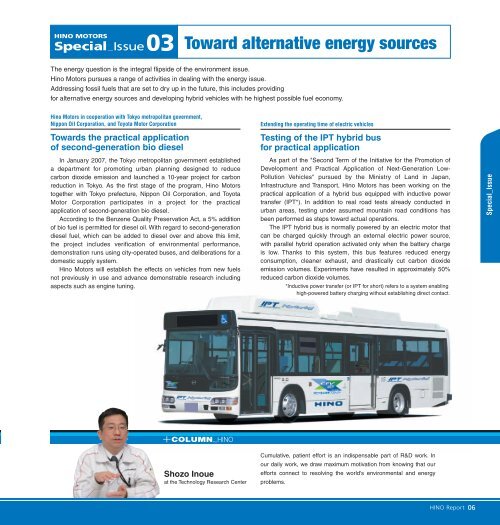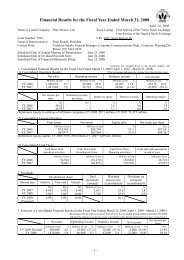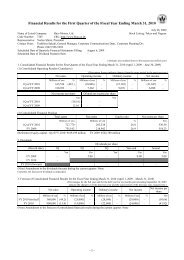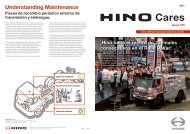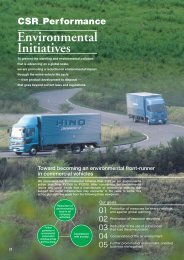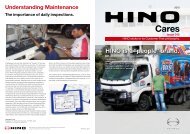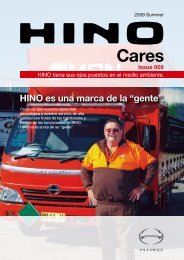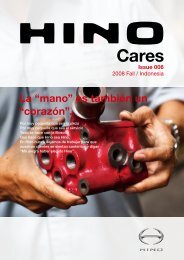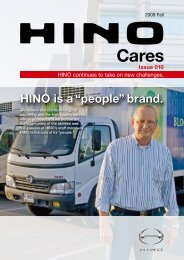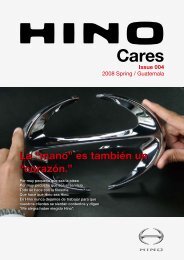Hino Motors Annual Report - hino global
Hino Motors Annual Report - hino global
Hino Motors Annual Report - hino global
Create successful ePaper yourself
Turn your PDF publications into a flip-book with our unique Google optimized e-Paper software.
HINO MOTORS<br />
Special Issue03<br />
Toward alternative energy sources<br />
The energy question is the integral flipside of the environment issue.<br />
<strong>Hino</strong> <strong>Motors</strong> pursues a range of activities in dealing with the energy issue.<br />
Addressing fossil fuels that are set to dry up in the future, this includes providing<br />
for alternative energy sources and developing hybrid vehicles with he highest possible fuel economy.<br />
<strong>Hino</strong> <strong>Motors</strong> in cooperation with Tokyo metropolitan government,<br />
Nippon Oil Corporation, and Toyota Motor Corporation<br />
<br />
Towards the practical application<br />
<br />
of second-generation bio diesel<br />
<br />
In January 2007, the Tokyo metropolitan government established<br />
a department for promoting urban planning designed to reduce<br />
carbon dioxide emission and launched a 10-year project for carbon<br />
reduction in Tokyo. As the first stage of the program, <strong>Hino</strong> <strong>Motors</strong><br />
together with Tokyo prefecture, Nippon Oil Corporation, and Toyota<br />
Motor Corporation participates in a project for the practical<br />
application of second-generation bio diesel.<br />
According to the Benzene Quality Preservation Act, a 5% addition<br />
of bio fuel is permitted for diesel oil. With regard to second-generation<br />
diesel fuel, which can be added to diesel over and above this limit,<br />
the project includes verification of environmental performance,<br />
demonstration runs using city-operated buses, and deliberations for a<br />
domestic supply system.<br />
<strong>Hino</strong> <strong>Motors</strong> will establish the effects on vehicles from new fuels<br />
not previously in use and advance demonstrable research including<br />
aspects such as engine tuning.<br />
Extending the operating time of electric vehicles<br />
<br />
Testing of the IPT hybrid bus<br />
<br />
for practical application<br />
<br />
As part of the "Second Term of the Initiative for the Promotion of<br />
Development and Practical Application of Next-Generation Low-<br />
Pollution Vehicles" pursued by the Ministry of Land in Japan,<br />
Infrastructure and Transport, <strong>Hino</strong> <strong>Motors</strong> has been working on the<br />
practical application of a hybrid bus equipped with inductive power<br />
transfer (IPT*). In addition to real road tests already conducted in<br />
urban areas, testing under assumed mountain road conditions has<br />
been performed as steps toward actual operations.<br />
The IPT hybrid bus is normally powered by an electric motor that<br />
can be charged quickly through an external electric power source,<br />
with parallel hybrid operation activated only when the battery charge<br />
is low. Thanks to this system, this bus features reduced energy<br />
consumption, cleaner exhaust, and drastically cut carbon dioxide<br />
emission volumes. Experiments have resulted in approximately 50%<br />
reduced carbon dioxide volumes.<br />
*Inductive power transfer (or IPT for short) refers to a system enabling<br />
high-powered battery charging without establishing direct contact.<br />
Special_Issue<br />
COLUMN_HINO<br />
Shozo Inoue<br />
at the Technology Research Center<br />
Cumulative, patient effort is an indispensable part of R&D work. In<br />
our daily work, we draw maximum motivation from knowing that our<br />
efforts connect to resolving the world's environmental and energy<br />
problems.<br />
HINO <strong>Report</strong> 06


